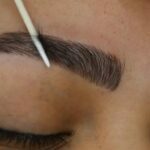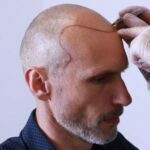Are you already ecstatic with the results of your recent scalp micropigmentation treatment and are enjoying the new you? Good for you! You belong to the brave group of people that have changed their lives with this revolutionary technique. But what’s next? That’s right, in order for the new you to shine 24/7 you need to make sure to follow a few guidelines, that include a moisturizing scalp.
With so many hair loss solutions out there, scalp micropigmentation has proven to be one of the most effective treatments around. However, you do need to look after your treatment to ensure consistent results. So if you’ve been wondering about scalp micropigmentation care, you are in the right place.
We’ll be sharing with you everything you need to know about what to do before and after the procedure to ensure you get the results of your dreams. With these care tips, you’ll be able to enjoy a fuller head of hair that will not only restore your hairline but also your self-esteem and confidence.
Moisturizing Scalp FAQ
Factors to keep in mind before Scalp MicroPigmentation?
- Preparing yourself prior to a scalp micropigmentation treatment can go a long way towards achieving better, long-lasting results. Consider these pre-care instructions prior to your SMP treatment.
- Identify the problem areas in your scalp, such as thinning hair, bald spots, or receding hairline; and take photos for reference. You can show the photos to the SMP technician for a more accurate assessment on how you want the treatment to be done.
- Moisturize your scalp, preferably with a water-based moisturiser.
- Avoid taking any pain relievers like aspirin and ibuprofen before the treatment. If you take such medications on a regular basis, consult your physician first and ask them if it’s okay to stop taking pain relievers for 48 hours before each session.
- Restrain from alcohol or caffeine consumption a day before the procedure as these beverages can worsen the pain.
What should I do after scalp micropigmentation?
In general, you’ll want to treat your scalp like an open wound after SMP treatment. Meaning, avoid getting it wet and keep it clean. No chlorinated pools, saunas, steam rooms, or tanning beds for 28 days after your final treatment. This will ensure a good, long-lasting result.
How long does micropigmentation take to heal?
It usually takes around 7-10 days for the scalp to fully heal. For the first few days, the area of treatment may appear red. This should be no cause for alarm, and it indicates the body is doing what it’s supposed to be doing.
Why is moisturizing important?
- This is especially important if you suffer from dry skin as skin flaking can remove some of the pigments deposited after the first session.
- At least one week after your treatment, it is a good idea to begin moisturizing the scalp again. You need to wait at least one week because the scalp is still in the healing process during this time.
- Some patients are concerned with getting the right kind of moisturizer, and they want to know how often they should do it. The important thing is that your scalp receives moisturizer a few times a week. Staying hydrated also helps prevent the scalp from drying out.
What can I use to moisturize my scalp after micropigmentation?
HeadLube Matte Aftershave Moisturizer Lotion
HeadBlade HeadLube Matte Lotion is effective at giving the scalp a more consistent appearance with the rest of your skin.
HeadLube is specially formulated moisturizer for your scalp and won’t clog your pores. Use HeadLube after every shave. This moisturizer will not leave your skin dry. apply anywhere.
HeadLube is the solution to dry skin after shaving.

Features:
- Perfume and dye-free
- Shea butter and tea tree oil
What should be avoided after SMP?
- Avoid soaking your head in water for about 3-5 days. Also, avoid any activities that cause you to sweat profusely.
- Minimize sun exposure to your scalp as much as possible. The sun’s UV rays can break down the pigments and cause premature fading. Ideally, you should wear a scalp or use an umbrella whenever you’re exposed to the sun.
- You may notice a bit of swelling the first few days after the treatment. This is completely normal and should not be a cause of concern. For temporary relief, place a small towel over your head and put an ice bag on top.
- Do not scrub, scratch, or comb your scalp. If it becomes too itchy, use your fingertips instead of your nails to avoid taking off some of the pigments.
- Avoid any makeup around the treated area until the area is fully healed.
- Avoid excessive sweating, saunas, facial massage (especially during the first week). Excessive sweat can make the pigments look blotchy and ruin the appearance of your treatment.
- You can then wash your scalp on the 5th day with a mild shampoo.
What does long-term care involve after SMP?
- Keep your scalp moisturized each day. Use moisturizer right after taking a shower and before going to bed. This helps minimize dry scalp and prevents the flaking of the pigments.
- Apply sunscreen to your scalp with an SPF of 30-50 to preserve the color of the pigments and prevent them from fading.
- Refrain from using hair care products that contain alcohol in them. Alcohol can be absorbed by your scalp and make the pigments look blotchy, so it’s best to avoid them as much as possible.
- Exfoliate your scalp at least once a week to remove dead skin cells and maintain the appearance of the pigments.
What to expect after SMP?
- Mild tenderness, swelling, and redness in the treatment area during the first 24 hours is completely normal.
- After 72 hours you may cleanse the treated area with Witch Hazel, or natural soap, and use a tattoo salve daily. Lightly apply a thin layer over the treated area without much friction.
- Scabbing is a normal part of the healing process. Scabbing will typically be the same color as the pigment that was used. If you pick or scrub your scab, you risk pulling out the color or causing hypertrophic scarring. Be patient with the healing process.
- In the first week or so you may experience over pigmentation and the area may appear darker than the final result. Do not freak out. After all crusts/scabs are gone some white spots or indefinite color may occur for 15+ days. Be patient.
- Wait at least 3 months from your touch-up to schedule any microdermabrasion, laser treatments, or chemical peels as these procedures can destroy your results if the area is not covered.
How to reduce the look of a shiny scalp?
Sometimes our clients notice a slight shine on their scalp and want to prevent this from happening. Milk of Magnesia is easy to find, relatively cheap, and it’s an effective product for reducing any shine on the scalp.
Why is important to avoid the sun?
The sun generates UV rays that damage your scalp micropigmentation treatment, causing it to fade more quickly. To achieve the longest-lasting results possible, we recommend sunscreen that is SPF 30 or higher. It’s important to remember that even if you can tan easily and do not usually experience a sunburn, the UV rays still damage the scalp micropigmentation’s coloration.
When should you consult a doctor?
Unexpected or prolonged redness, tenderness, swelling, any rash, and unexpected drainage at or from the site of the procedure. In the event of these symptoms, contact your professional immediately.
Moisturizing Scalp MicroPigmentation Care Additional Tips
- Your menstrual cycle can cause your skin to be more sensitive than normal and some clients may wish to schedule around their cycle.
- If you have recently completed Chemotherapy, you should obtain your physician’s consent in writing.
- Please know that Micropigmentation cannot be performed on any woman who is pregnant or breastfeeding.
- Do not schedule your appointment immediately before a vacation in which you will have increased sun exposure.



